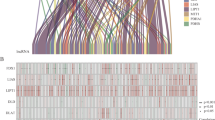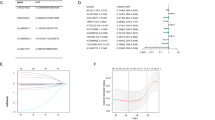Abstract
Background
Cuproptosis is the most recently identified form of cell death, and copper homeostasis is an important cancer therapeutic target. However, the therapeutic benefits of cuproptosis-targeted treatment in BRCA remain undetermined. This study utilized LncRNAs linked to cuproptosis genes and immune checkpoint genes to generate a BRCA predictive signature.
Methods
We screened a population of LncRNAs that correlated with both cuproptosis genes and immune checkpoint genes and used ten of these LncRNAs to construct a prognosis-predictive signature. We then validated and proved the efficacy of the signature in predicting the prognosis of BRCA patients. We also unraveled the relationship between the signature and the immunological milieu, immune function, and susceptibility to chemotherapy.
Results
The signature derived from the ten cuproptosis- and immune-related prognostic LncRNAs (CuImP-LncRNAs) can be implied to categorize patients into two groups, including the high- and low-risk groups. The value of the signature was validated, and the risk score was verified as an independent prognostic indicator. The TIME and TMB distribution patterns and chemosensitivity were depicted in the high- and low-risk groups, respectively. Patients of the high-risk group with a suppressive immunological intratumor context were more sensitive to a broad range of antitumor agents. In contrast, low-risk individuals with active immune function responded more favorably to immunotherapy.
Conclusion
Our findings provided a novel and effective model for predicting BRCA prognosis and the propensity to different treatment modalities, thus contributing to the optimization of personalized BRCA therapy in the future.










Similar content being viewed by others
Data availability
The datasets used in this study can be found in the TCGA database (https://portal.gdc.cancer.gov), GSEA (http://www.gsea-msigdb.org/gsea/index.jsp), TIMER database (http://cistrome.dfci.harvard.edu/TIMER/), and GDSC (https://www.cancerrxgene.org/).
Abbreviations
- CuImP-LncRNAs:
-
Cuproptosis- and immune-related prognostic LncRNAs
- TCGA:
-
The Cancer Genome Atlas
- TIME:
-
Tumor immune microenvironment
- TMB:
-
Tumor mutation burden
- LASSO:
-
Least absolute shrinkage and selection operator
- GDSC:
-
Genomics of drug sensitivity in cancer
- OS:
-
Overall survival
- PFS:
-
Progression-free survival
- IPS:
-
Immunophenoscore
- ROC:
-
Receiver operator characteristic
- AUC:
-
Area under the ROC curve
- PCA:
-
Principal component analysis
- IC50:
-
Half-maximal inhibitory concentration
References
Siegel RL, Miller KD, Fuchs HE, Jemal A. Cancer Statistics, 2021. CA Cancer J Clin. 2021;71(1):7–33.
Miller KD, Fidler-Benaoudia M, Keegan TH, Hipp HS, Jemal A, Siegel RL. Cancer statistics for adolescents and young adults, 2020. CA Cancer J Clin. 2020;70(6):443–59.
Ruddy KJ, Gelber S, Tamimi RM, Schapira L, Come SE, Meyer ME, et al. Breast cancer presentation and diagnostic delays in young women. Cancer. 2014;120(1):20–5.
Anders CK, Johnson R, Litton J, Phillips M, Bleyer A. Breast cancer before age 40 years. Semin Oncol. 2009;36(3):237–49.
Yu F, Quan F, Xu J, Zhang Y, Xie Y, Zhang J, et al. Breast cancer prognosis signature: linking risk stratification to disease subtypes. Brief Bioinform. 2019;20(6):2130–40.
Bao G, Xu R, Wang X, Ji J, Wang L, Li W, et al. Identification of lncRNA signature associated with pan-cancer prognosis. IEEE J Biomed Health Inform. 2021;25(6):2317–28.
Bandmann O, Weiss KH, Kaler SG. Wilson’s disease and other neurological copper disorders. Lancet Neurol. 2015;14(1):103–13.
Denoyer D, Masaldan S, La Fontaine S, Cater MA. Targeting copper in cancer therapy: “Copper That Cancer.” Metallom Integr Biometal Sci. 2015;7(11):1459–76.
Wang W, Wang X, Luo J, Chen X, Ma K, He H, et al. Serum copper level and the copper-to-zinc ratio could be useful in the prediction of lung cancer and its prognosis: a case–control study in Northeast China. Nutr Cancer. 2021;73(10):1908–15.
Oliveri V. Selective targeting of cancer cells by copper ionophores: an overview. Front Mol Biosci. 2022;9: 841814.
Shanbhag VC, Gudekar N, Jasmer K, Papageorgiou C, Singh K. Copper metabolism as a unique vulnerability in cancer. Biochim Biophys Acta Mol Cell Res. 2021;2:118893.
Tsvetkov P, Coy S, Petrova B, Dreishpoon M, Verma A, Abdusamad M, et al. Copper induces cell death by targeting lipoylated TCA cycle proteins. Science. 2022;375(6586):1254–61.
Choi R, Kim M-J, Sohn I, Kim S, Kim I, Ryu JM, et al. Serum trace elements and their associations with breast cancer subgroups in Korean breast cancer patients. Nutrients. 2018;11(1):2.
Blockhuys S, Brady DC, Wittung-Stafshede P. Evaluation of copper chaperone ATOX1 as prognostic biomarker in breast cancer. Breast Cancer (Tokyo, Japan). 2020;27(3):505–9.
Milacic V, Jiao P, Zhang B, Yan B, Dou QP. Novel 8-hydroxylquinoline analogs induce copper-dependent proteasome inhibition and cell death in human breast cancer cells. Int J Oncol. 2009;35(6):1481–91.
André F, Bachelot T, Commo F, Campone M, Arnedos M, Dieras V, et al. Comparative genomic hybridisation array and DNA sequencing to direct treatment of metastatic breast cancer: a multicentre, prospective trial (SAFIR01/UNICANCER). Lancet Oncol. 2014;15(3):267–74.
Karn T, Denkert C, Weber KE, Holtrich U, Hanusch C, Sinn BV, et al. Tumor mutational burden and immune infiltration as independent predictors of response to neoadjuvant immune checkpoint inhibition in early TNBC in GeparNuevo. Ann Oncol. 2020;31(9):1216–22.
Voli F, Valli E, Lerra L, Kimpton K, Saletta F, Giorgi FM, et al. Intratumoral copper modulates PD-L1 expression and influences tumor immune evasion. Can Res. 2020;80(19):4129–44.
Liu YL, Bager CL, Willumsen N, Ramchandani D, Kornhauser N, Ling L, et al. Tetrathiomolybdate (TM)-associated copper depletion influences collagen remodeling and immune response in the pre-metastatic niche of breast cancer. NPJ Breast Cancer. 2021;7(1):108.
Hu F-F, Liu C-J, Liu L-L, Zhang Q, Guo A-Y. Expression profile of immune checkpoint genes and their roles in predicting immunotherapy response. Brief Bioinform. 2021;22:3.
Charoentong P, Finotello F, Angelova M, Mayer C, Efremova M, Rieder D, et al. Pan-cancer immunogenomic analyses reveal genotype-immunophenotype relationships and predictors of response to checkpoint blockade. Cell Rep. 2017;18(1):248–62.
Yang W, Soares J, Greninger P, Edelman EJ, Lightfoot H, Forbes S, et al. Genomics of drug sensitivity in cancer (GDSC): a resource for therapeutic biomarker discovery in cancer cells. Nucleic Acids Res. 2013;41:955–61.
Mayakonda A, Lin D-C, Assenov Y, Plass C, Koeffler HP. Maftools: efficient and comprehensive analysis of somatic variants in cancer. Genome Res. 2018;28(11):1747–56.
Rizvi NA, Hellmann MD, Snyder A, Kvistborg P, Makarov V, Havel JJ, et al. Cancer immunology. Mutational landscape determines sensitivity to PD-1 blockade in non-small cell lung cancer. Science. 2015;348(6230):124–8.
Veer LJ, Dai H, van de Vijver MJ, He YD, Hart AAM, Mao M, et al. Gene expression profiling predicts clinical outcome of breast cancer. Nature. 2002;415(6871):530–6.
Li B, Zhang B, Wang X, Zeng Z, Huang Z, Zhang L, et al. Expression signature, prognosis value, and immune characteristics of Siglec-15 identified by pan-cancer analysis. Oncoimmunology. 2020;9(1):1807291.
Chen Y-T, Xiang D, Zhao X-Y, Chu X-Y. Upregulation of lncRNA NIFK-AS1 in hepatocellular carcinoma by mA methylation promotes disease progression and sorafenib resistance. Hum Cell. 2021;34(6):1800–11.
Santangelo A, Rossato M, Lombardi G, Benfatto S, Lavezzari D, De Salvo GL, et al. A molecular signature associated with prolonged survival in glioblastoma patients treated with regorafenib. Neuro Oncol. 2021;23(2):264–76.
Shi G-J, Zhou Q, Zhu Q, Wang L, Jiang G-Q. A novel prognostic model associated with the overall survival in patients with breast cancer based on lipid metabolism-related long noncoding RNAs. J Clin Lab Anal. 2022;2:e24384.
Peggs KS, Quezada SA, Allison JP. Cell intrinsic mechanisms of T-cell inhibition and application to cancer therapy. Immunol Rev. 2008;224:141–65.
Xu M, Li Y, Li W, Zhao Q, Zhang Q, Le K, et al. Immune and stroma related genes in breast cancer: a comprehensive analysis of tumor microenvironment based on the cancer genome atlas (TCGA) database. Front Med. 2020;7:64.
Holmgaard RB, Zamarin D, Munn DH, Wolchok JD, Allison JP. Indoleamine 2,3-dioxygenase is a critical resistance mechanism in antitumor T cell immunotherapy targeting CTLA-4. J Exp Med. 2013;210(7):1389–402.
Wang M, Du Q, Jin J, Wei Y, Lu Y, Li Q. LAG3 and its emerging role in cancer immunotherapy. Clin Transl Med. 2021;11(3): e365.
Samstein RM, Lee C-H, Shoushtari AN, Hellmann MD, Shen R, Janjigian YY, et al. Tumor mutational load predicts survival after immunotherapy across multiple cancer types. Nat Genet. 2019;51(2):202–6.
Zhang Z, Hao R, Guo Q, Zhang S, Wang X. TP53 mutation infers a poor prognosis and is correlated to immunocytes infiltration in breast cancer. Front Cell Dev Biol. 2021;9: 759154.
Duffy MJ, Synnott NC, Crown J. Mutant p53 in breast cancer: potential as a therapeutic target and biomarker. Breast Cancer Res Treat. 2018;170(2):213–9.
O’Day S, Gonzalez R, Lawson D, Weber R, Hutchins L, Anderson C, et al. Phase II, randomized, controlled, double-blinded trial of weekly elesclomol plus paclitaxel versus paclitaxel alone for stage IV metastatic melanoma. J Clin Oncol. 2009;27(32):5452–8.
Qu Y, Wang J, Sim M-S, Liu B, Giuliano A, Barsoum J, et al. Elesclomol, counteracted by Akt survival signaling, enhances the apoptotic effect of chemotherapy drugs in breast cancer cells. Breast Cancer Res Treat. 2010;121(2):311–21.
Acknowledgements
We thank all research groups who established and updated all open-access databases used in this study.
Funding
This study was supported by grants from the Lanzhou Science and Technology Bureau (2022-ZD-62) and the Natural Science Foundation of Gansu Province (21JR7RA662).
Author information
Authors and Affiliations
Contributions
YL and JP conceived and designed this study, and JP conducted the data collection and analyses. YL reviewed the analysis results and wrote the manuscript. FN revised the manuscript. All authors agreed to the final manuscript.
Corresponding author
Ethics declarations
Conflict of interest
The authors declare that there is no conflict of interest regarding the publication of this study.
Ethical approval
This article does not contain any studies with human participants or animals performed by any authors.
Consent to participate
Not applicable.
Consent for publication
Not applicable.
Additional information
Publisher's Note
Springer Nature remains neutral with regard to jurisdictional claims in published maps and institutional affiliations.
Electronic supplementary material
Below is the link to the electronic supplementary material.
About this article
Cite this article
Li, Y., Na, F. & Pei, J. Construction and characterization of a cuproptosis- and immune checkpoint-based LncRNAs signature for breast cancer risk stratification. Breast Cancer 30, 393–411 (2023). https://doi.org/10.1007/s12282-023-01434-9
Received:
Accepted:
Published:
Issue Date:
DOI: https://doi.org/10.1007/s12282-023-01434-9




